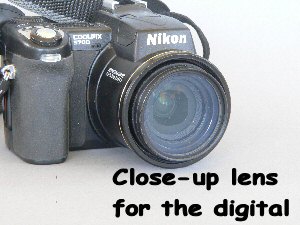
Most advertising about digital camera's capability to take close-ups is accurate but misleading in my opinion. The important factor is not how close the camera will focus but how much of the subject is taken. The figures quoted range between 1cm and 10cm [3/4" < 4"]. That 1cm sounds good until you find you have to be at the wide-angle setting of the zoom. The Panasonic FZ20 shown on this page focuses down to 5cm at wide-angle but the moment you zoom in, the closest focusing distance rapidly increases to 6'6". On the other hand the Nikon 5700 only goes into Macro when the zoom is around mid-point.
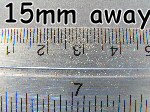
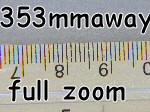
The Nikon 5700 works in Macro across the middle of the zoom and achieves 30mm with the lens on top of the subject. Add a 2 dioptre and one gets the same result but with the camera about 9 inches back.
On the left pushing the FZ20 much further than Panasonic says it will go, to a 15mm distance of lens-to-subject, removing adaptor tube and lenshood to let light in on the subject, I got a moderately sharp 45mm across the subject. At 5cm it is 75mm across.
Using full zoom and a 2 dioptre results in 35mm across. Although 2 dioptre has a focal length of 500mm with the camera's focusing ability added I got into 353mm. With plenty of room for light to get on the subject.
The title shot shows what I think is an elegant adaption for the 5700 fitting snugly against the body when camera switched off. There is a 43mm rim about 3mm deep on the front of the lens and I turned down a 43.5<46mm step-up ring to fit. It stuck as I checked the fit and has stayed there the past two years or more. More than one filter/lens and it vignettes but is nicely placed to move in and out with the lens. The UR-E8 register rim for WA or Tele adaptors also was turned down to clear the 46mm filters. My Raynox x2.2Pro tele converter on it's adaptor tube works AOK with the UV filter still in place.
Because many digital zooms move in and out as they zoom and focus, adaptors need to be adjustable if the filter is going to be held close in front of the camera lens. Because they are way out in front they also need to be big to avoid vignetting at wide-angle.
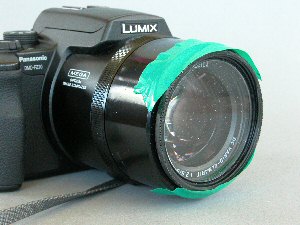
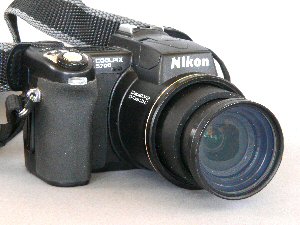
An easy solution if you have filters the same or near same diameter as the lens barrel is to simply tape the filter on. With caution that it doesn't foul things up when the barrel disappears into the camera on shut-down. Thin cellotape is better than electrical tape I used here. Left is using an adaptor tube and right onto the lens barrel itself.
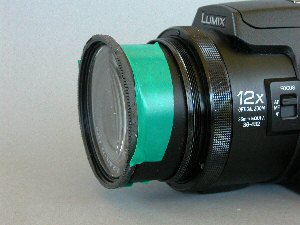
There is no reason why one shouldn't stack CU lens in moderation as on right where a pair of two dioptres of different sizes from other cameras in my collection were used at full zoom to achieve a subject area of 19mm across with the FZ20.
But there is a definite limit to the amount of magnification you can achieve this way. Seethis.
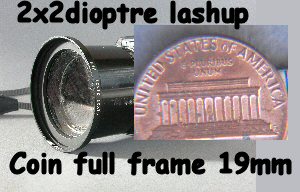
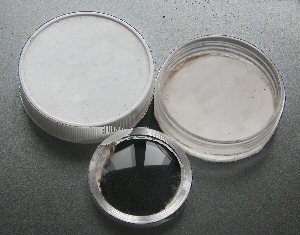
If you are not going to take many big close-ups, and are not after the absolute ultimate in quality, good close-ups can be taken with plastic 'hobby-glass' lens. Easy to cut and file. This is one to be taped to my wife's FZ3 with it's box made out of a plastic honey jar, using just the thread portion of the jar. Lined with tissue to protect the lens ...plastic scratches easily.
If you appreciate that the camera lens when it focuses to 5cm is actually a 20 dioptre lens.
So adding a 4 dioptre CU lens isn't adding much to the pile. [A dioptre is 1000mm ... 1000/20=50mm or 20 dioptre lens]
Most of the above applies to Point and Shoot cameras so long as they have an LCD to frame up with. But if you do tricks like adding a 50mm SLR lens to a P&S with limited zoom you get extreme vignetting. It works with a longer zoom though. [x8<x12]
I have a suspicion that adding a CU lens to a P&S helps/forces the AF to focus properly at the very close distances.
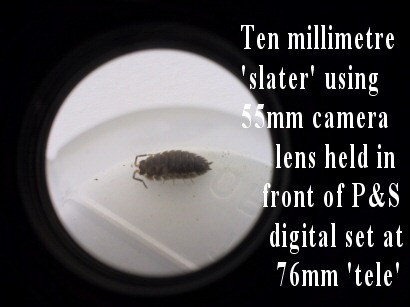
There seems to be two schools of thought with regard to Depth of Field. One goes on the assumption that the shorter the focal length of the lens the more DoF is available. This is generally correct.
The other school points out that DoF decreases as the lens approaches the subject and suggest that so long as the subject size remains the same within the frame the DoF is the same whatever lens you use.
Whichever is correct the use of a close-up lens helps to keep the camera away from the subject when coupled to a long focal length lens [zoom] and gives plenty of room to light the subject matter. So regular flash guns can be used instead of special macro-flash units.